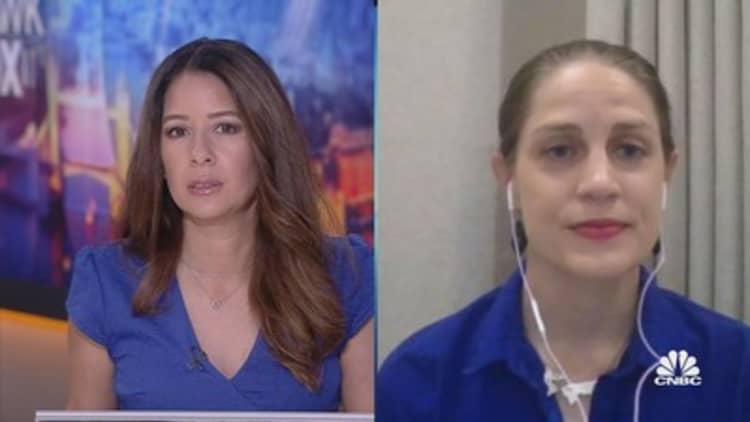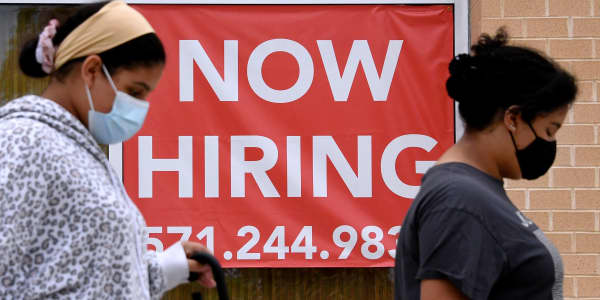For 33-year-old Rouaya raising five children in a small village in Akkar, north Lebanon, times are hard.
Following the dual crises of the Covid-19 pandemic and Lebanon's economic collapse, she has had to double her workload, "working in the fields and in the house." But still, she struggles to earn enough money to eat. Russia's invasion of Ukraine and its impact on food supplies has only made matters worse.
"Often I don't have enough money to purchase food to cook, so I give the children bread sprinkled with thyme. Sometimes, too, we only eat twice a day. Times have never been so bad," she said.
Rouaya is not alone. She is one of tens of millions of women worldwide who find themselves eating last and eating least as a worsening food crisis exacerbates existing gender inequality issues.
A growing gender disparity in food access
Of the estimated 828 million people globally who were affected by hunger in 2021, around three-in-five (59%) were women, according to a report released earlier this month by humanitarian organization Care.
That's equivalent to 150 million more women facing food insecurity than men.
And the gap is widening.
Since 2018, the disparity between men's and women's food security has grown 8.4 times, accelerated in part by the coronavirus pandemic. Now, with the onset of Russia's war in Ukraine and accompanying food shortages, alongside wider inflationary factors, the situation looks set to deteriorate further.
The implications are astronomical ... we know they're going to fall heavily on women and girls.Emily JanochSenior director of thought leadership at Care
"Not only is that a stark gap, it is a gap compared to 2018 that is growing rapidly," Emily Janoch, Care's senior director of thought leadership and one of the report's authors told CNBC.
The findings, which draw on data from the United Nations and World Bank, report the state of play up to Dec. 2021. The fallout from the crises of 2022 will not be known until next year, but the forecast looks bleak.
"Everything that we're seeing is telling us that it's going to get worse," Janoch said.
"If you look at the impact on agriculture following the Russian fertilizer crisis, the implications are astronomical. We don't know exactly what they will look like, but we know they're going to fall heavily on women and girls," she said.
Food insecurity rises as gender equality falls
According to the U.N.'s 2022 'The state of food security and nutrition in the world' report, women have poorer food security than men in every region in the world. That disparity is especially pronounced in developing countries and specifically in the Global South.
Care's report also found that as gender inequality increased across 109 countries, so too did food insecurity. In Sudan, for instance — which the World Bank scored a 2.5 out of 6 for gender equality —almost two-thirds of women (65%) reported being food insecure versus nearly half (49%) of men.
That as girls and women are responsible for 85-90% of household food preparation globally and most food shopping, according to the U.N.'s Food and Agriculture Organization.
"Women are very heavily socialized to pull that burden on themselves. And everyone around them is socialized to assume that they will," Janoch said.
Indeed, even when both men and women are technically food insecure, women still tend to bear the bigger burden.
In Somalia, for example, men reported eating smaller meals while women reported skipping meals altogether.
In Lebanon, at the start of the Covid-19 pandemic, 85% of people reported reducing the number of meals they ate, but more women (85%) than men (57%) reported eating smaller portions too.
Meantime, in Bangladesh, one in five (21%) women reported experiencing increased violence at home as a result of higher food prices.
'A dollar in the hands of a woman'
Such gendered food security gaps have major implications not only for women and the families for whom they may be responsible but also for the wider economy.
Often, large portions of women's economic contributions go unrecognized or are hard to calculate — at least in economic data. Indeed, the IMF estimates that the economic value of unpaid work, which it says is mostly done by women, accounts for between 10% and 60% of gross domestic product.
Rebecca Burgess, country director at The Hunger Project U.K., said that further enabling women's economic participation and decision-making — both at a household and legislative level — would go a long way to reducing poverty and improving nutritional outcomes across the board.
[Women] routinely invest significant portions of their income in food, health care and education for their families.Rebecca BurgessCountry director at The Hunger Project U.K.
"A proven way to overcome many systematic barriers to a woman's success has been increased participation by women in local, regional and national legislation as empowered change agents," Burgess told CNBC.
"Time and time again studies have demonstrated that when women are given the opportunity to generate and control an income, they routinely invest significant portions of their income in food, health care and education for their families," she said.
Indeed, a 2021 Care study from Burundi found that investing in gender equality in agriculture brought a $5 return for every $1 invested, compared to a $2 return for every $1 invested in agriculture programs that ignored gender equality.
"Women are huge players in economic supply chains that are not always seen," Janoch said. "A dollar in the hands of a woman goes further to increase food security."








